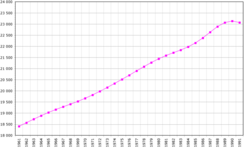- Demographics of the Socialist Federal Republic of Yugoslavia
-
This article is about the demographics of the Socialist Federal Republic of Yugoslavia during its existence from 1945 until 1991. With the dissolution of the state, the following nations now have their own demographic studies:
- Demographics of Bosnia and Herzegovina
- Demographics of Croatia
- Demographics of Macedonia
- Demographics of Montenegro
- Demographics of Serbia
- Demographics of Slovenia
Contents
Demographics
This is data from two Yugoslav censa (1971 and 1981). Nations that were considered to be constituent appear in bold text.
Nationality 1971 % 1981 % Serbs 8,143,246 39.7% 8,136,578 36.3% Croats 4,526,782 22.1% 4,428,135 19.7% Muslims (Bosniaks) 1,729,932 8.4% 2,000,034 8.9% Slovenes 1,678,032 8.2% 1,753,605 7.8% Albanians 1,309,523 6.4% 1,731,252 7.7% Macedonians 1,194,784 5.8% 1,341,420 6.0% Yugoslavs 273,077 1.3% 1,216,463 5.4% Montenegrins 508,843 2.5% 577,298 2.6% Hungarians 477,374 2.3% 426,865 1.9% Roma 78,485 0.4% 148,604 0.7% Turks 127,920 0.6% 101,328 0.5% Slovaks 83,656 0.4% 80,300 0.4% Romanians 58,570 0.3% 54,721 0.2% Bulgarians 58,627 0.3% 36,642 0.2% Vlachs 21.990 0.1% 32,071 0.1% Ruthenians 24.640 0.1% 23,320 0.1% Czechs 24.620 0.1% 19,609 0.1% Italians 21,791 0.1% 15,116 0.1% Ukrainians 13.972 0.1% 12,716 0.1% Germans 12.875 0.1% ? ? Russians 7.427 ? ? Jews 4.811 ? ? Poles 4.033 ? ? Greeks 1.564 ? ? other/not determined 136.398 0.6% 302,254 1.5% total 20,522,972 100.0% 22,438,331 100.00% Republics by population
The population data is from the 1991 census.
Rank Republic/Province Population % Density 1 Serbia 9,506,174 40.9% 114.0 --- Serbia proper 5,582,611 24.0% 99.4 2 Croatia 4,784,265 20.6% 84.6 3 Bosnia and Herzegovina 4,377,053 18.8% 85.6 4 Macedonia 2,033,964 8.8% 79.1 --- Vojvodina 1,996,367 8.6% 92.8 --- Kosovo 1,956,196 8.4% 183.1 5 Slovenia 1,913,355 8.2% 94.5 6 Montenegro 615,035 2.6% 44.5 SFR Yugoslavia 23,229,846 100% 92.6 Republics by area
Rank Republic/Province Area (km²) % Density 1 Serbia 88,361 33.2% 114.0 2 Croatia 56,524 22.5% 84.6 --- Serbia proper 56,169 22.4% 99.4 3 Bosnia and Herzegovina 51,129 20.4% 85.6 4 Macedonia 25,713 10.3% 79.1 --- Vojvodina 21,506 8.6% 92.8 5 Slovenia 20,246 8.1% 94.5 6 Montenegro 13,810 5.5% 44.5 --- Kosovo 10,686 4.3% 183.1 SFR Yugoslavia 250,790 100% 92.6 Republics by population density
Rank Republic/Province Population Area (km²) Density --- Kosovo 1,956,196 10,686 183.1 1 Serbia 9,506,174 83,361 114.0 --- Serbia proper 5,582,611 56,169 99.4 2 Slovenia 1,913,355 20,246 94.5 --- Vojvodina 1,996,367 21,506 92.8 3 Bosnia and Herzegovina 4,377,053 51,129 85.6 4 Croatia 4,784,265 56,524 84.6 5 Macedonia 2,033,964 25,713 79.1 6 Montenegro 615,035 13,810 44.5 SFR Yugoslavia 23,229,846 250,790 92.6 History of the national minorities under Communism
1940s and 1950s
The SFRY recognised "nations" (narodi) and "nationalities" (narodnosti) separately; the former included the constituent Slavic peoples, while the latter included other Slavic and non-Slavic ethnic groups such as Bulgarians and Slovaks (Slavic); and Hungarians and Albanians (non-Slavic). About a total of 26 known ethnic groups were known to live in Yugoslavia, including non-European originated Roma People or Gypsies.
For the Slavic majority, four non-slavic national minorities - Hungarians, Germans, Albanians and Italians - had proved troublesome already in the first Yugoslavia[1]. Education in Hungarian was limited, a number of Hungarian and German cultural societies had been banned in the Kingdom of Yugoslavia until the late 1930s, when Yugoslavia drifted to pro-axis positions. Nonetheless, local Germans collaborated with the Nazi occupation forces during the World War II, and ethnic Hungarians generally welcomed the Hungarian annexation of Backa etc. The Yugoslav communist partisan movement was unpopular among those minorities, with the German Ernst Thälmann unit existing merely on paper and the Hungarian Petőfi unit numbering mere hundred men. After the occupation forces were pushed out of Yugoslavia, Germans, Hungarians and Italians were treated with severity by the victorious partisans.
The overwhelming majority of Germans were expelled or fled, fearing reprisals. Similarly, tens of thousands of Hungarians fell victim to the ethnic cleansing in Vojvodina. However, after the war, free education in the native language of the minorities were guaranteed by the Communist constitution.
During the era of Tito-Stalin split, many Hungarians (who in 1953 made up around 25% of the population in Vojvodia[2]) were sympathetic towards the Hungarian People's Republic, and the words of Radio Budapest spread among the villagers.
In 1950s, the Bulgarians were reported to be a poor and backward minority, in contrast, the Czechs and Slovaks were “industrious and valuable minorities” for Yugoslavia. Some of them also emigrated after the war, a number of them returning after communists seized power in Czechoslovakia in 1948[3].
Sources
- ^ Yugoslavia's National Minorities under Communism by Paul Shoup In: Slavic Review, Vol. 22, No. 1 (Mar., 1963), pp. 64-81
- ^ Yugoslavia's National Minorities under Communism by Paul Shoup In: Slavic Review, Vol. 22, No. 1 (Mar., 1963), pp. 76
- ^ Yugoslavia's National Minorities under Communism by Paul Shoup In: Slavic Review, Vol. 22, No. 1 (Mar., 1963), p. 80
Socialist Federal Republic of Yugoslavia Categories:- Second Yugoslavia
Wikimedia Foundation. 2010.

